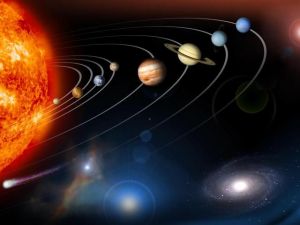Star system
For the star system in which the planet Earth is located, see Sol System.
A star system or solar system is the area around a star (or a group of stars) which contains all of the planets, moons, asteroids, nebulae and other landmarks which are held in place by the star's gravity well.
A Solar system's boundaries are usually marked by the area in which a star or celestial body's gravitational force affects its surrounding environment.
Often the edge of these boundaries is a large, thin layer of ice, dust and debris called an Oort cloud. (Source: NASA)
The planets and other bodies in a solar system orbit the star (or stars) at different distances; these distances can be classified into three distinct "zones":
- (1) the hot zone, which is closest to the star, produces temperatures prohibitive of life, such as on Mercury
- (2) the ecosphere zone, where life can find a foothold and flourish, given the balance between solar energy received and radiated, such as Earth, Vulcan, and Bajor
- (3) the cold zone, which lies farthest from the star and receives the least energy; Pluto orbits in the cold zone, where Sol appears merely as another bright star.
Using warp drive to travel from within a solar system to another point in the system is not recommended.
